Amphibians are a diverse group of vertebrate animals that include frogs, toads, salamanders, newts, and caecilians. The word amphibian comes from the Greek word “amphibios” which means double life. This refers to the fact that most amphibians have an aquatic larval stage followed by a terrestrial adult stage.
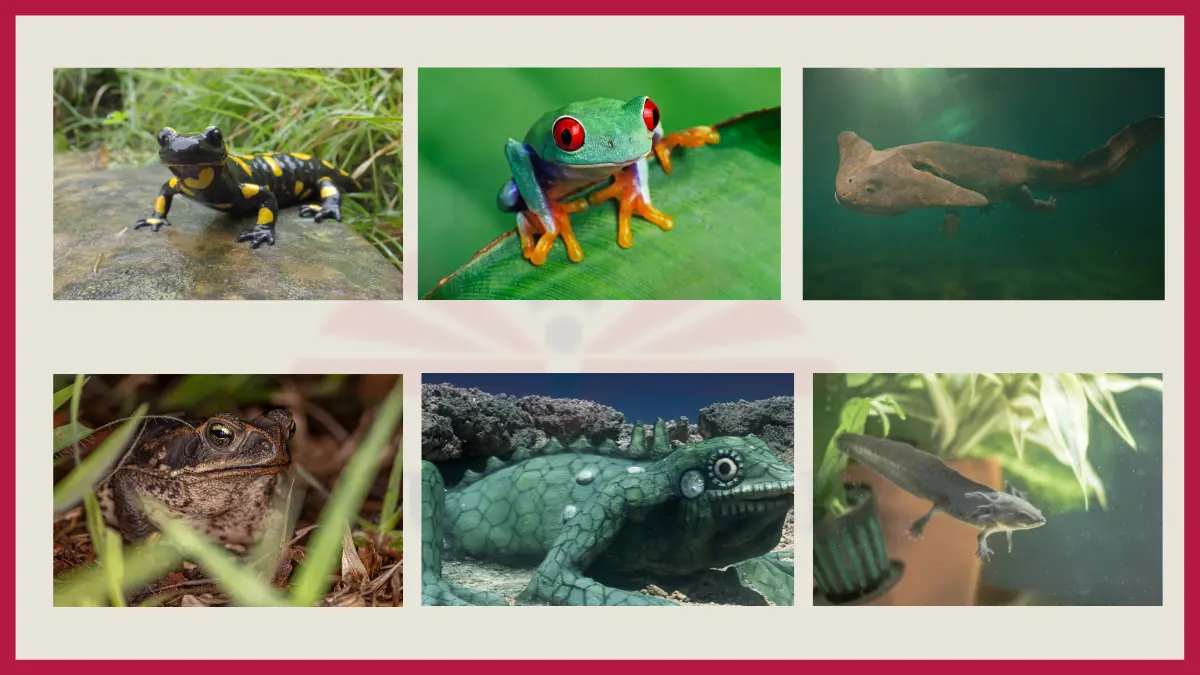
There are over 8,000 known species of amphibians around the world. They inhabit a wide variety of habitats including rainforests, deserts, marshes, streams, and ponds. Amphibians play important roles in food chains and ecosystems. They are predators that help regulate prey populations. They are also prey for many other animals. Their permeable skin and eggs make them valuable indicators of environmental health and pollution.
Evolution of Amphibians
Amphibians evolved from fish around 370 million years ago. They have adaptations that allow them to live both on land and in water. For example, they have lungs to breathe air, but they also have skin that can absorb oxygen from water.
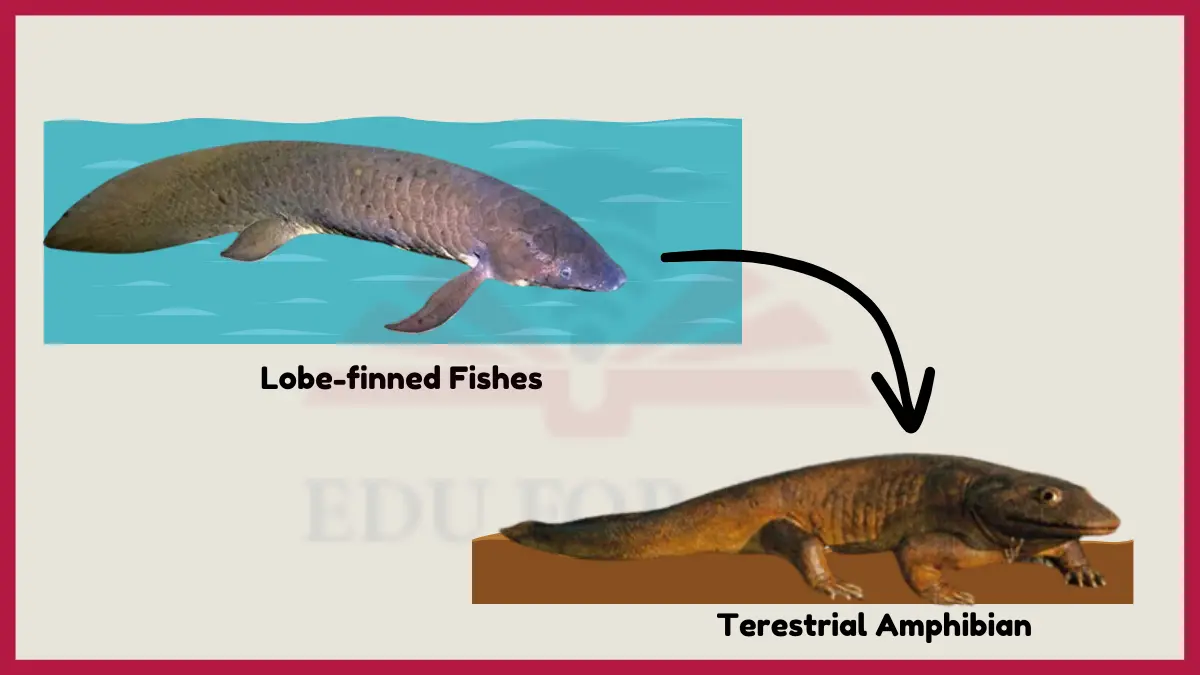
Amphibians were the dominant land vertebrates for a time, but reptiles eventually took over. Today, there are over 8,000 species of amphibians, but they are outnumbered by reptiles, birds, and mammals.
Amphibians are animals that can live both on land and in water. They evolved from fish around 370 million years ago. At one time, amphibians were the largest animals on land. But today, they are outnumbered by reptiles, birds, and mammals.
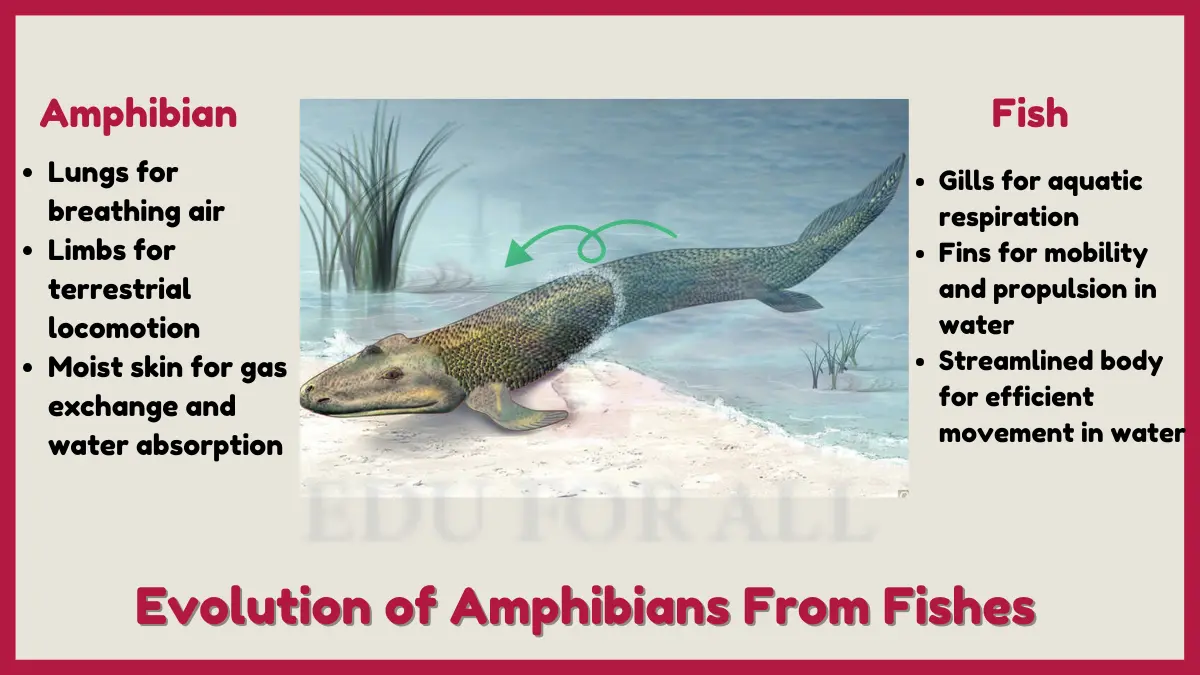
Timeline of amphibian evolution
- Devonian period (370 million years ago): Lobe-finned fish evolve adaptations that allow them to live on land.
- Carboniferous period (360 to 323 million years ago): Amphibians are the dominant land vertebrates.
- Permian period (299 to 252 million years ago): The development of the amniotic egg allows reptiles to reproduce on land and become the dominant land vertebrates.
- Triassic period (252 to 201 million years ago): Amphibians are outnumbered by reptiles, birds, and mammals.
- Present day: There are over 8,000 species of amphibians, but they are still outnumbered by other land vertebrates.
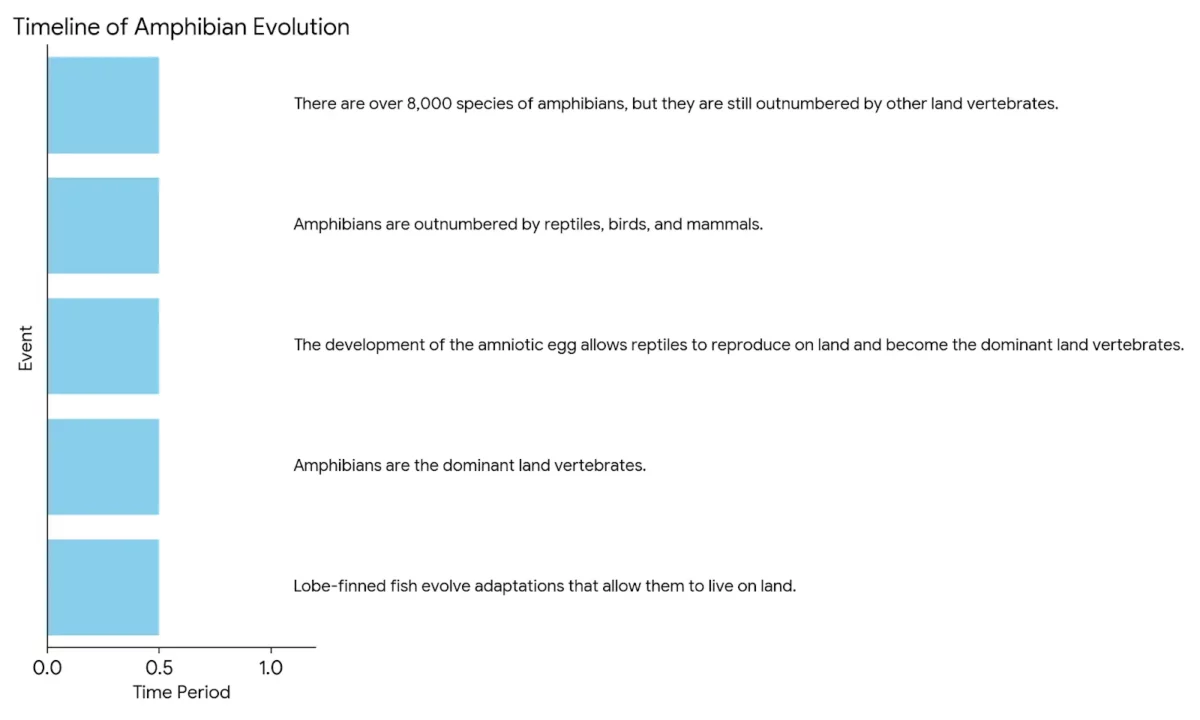
Key evolutionary Adaptations of Amphibians
Here are the Key evolutionary adaptations of amphibians:
1. Multi-jointed leg-like fins with digits
Amphibians evolved multi-jointed leg-like fins with digits to move from water to land. These fins, inherited from lobe-finned fish, allowed amphibians to move more effectively on land. Digits provided grip and traction, helping amphibians climb and hunt prey. This adaptation opened up new habitats for amphibians and played a vital role in their diversification.

2. Primitive lungs
Amphibians’ transition from water to land was facilitated by the development of primitive lungs. These lungs, evolved from fish gills, enabled amphibians to breathe air more efficiently, providing the necessary oxygen for their survival and growth on land. While not as complex as mammalian lungs, primitive lungs played a crucial role in amphibian adaptation to terrestrial environments.

3. Stronger skeletons
Amphibians evolved stronger skeletons to support their transition from aquatic to terrestrial environments. These skeletons, reinforced with additional bone density, provided the support necessary for amphibians to move and function effectively on land. The stronger skeletons also protected amphibians from the stresses of life on land, such as impacts from falls and the weight of their own bodies.

3. Hands and feet with five or more digits
The development of hands and feet with five or more digits was a key adaptation for amphibians, facilitating their transition from aquatic to terrestrial environments. These digits, providing enhanced grip and traction, enabled amphibians to navigate diverse land surfaces, climb, and hunt more effectively. The number of digits varied among amphibian species, but most possessed five fingers on their front limbs and four toes on their hind limbs.

4. Moist Skin
Amphibians developed specialized skin to retain body fluids and resist desiccation, enabling their survival in terrestrial environments. This skin, unlike fish scales, was moist and permeable, allowing amphibians to absorb water through their skin. The skin also contained glands that secreted mucus, which helped to prevent water loss and protect amphibians from harsh environmental conditions.
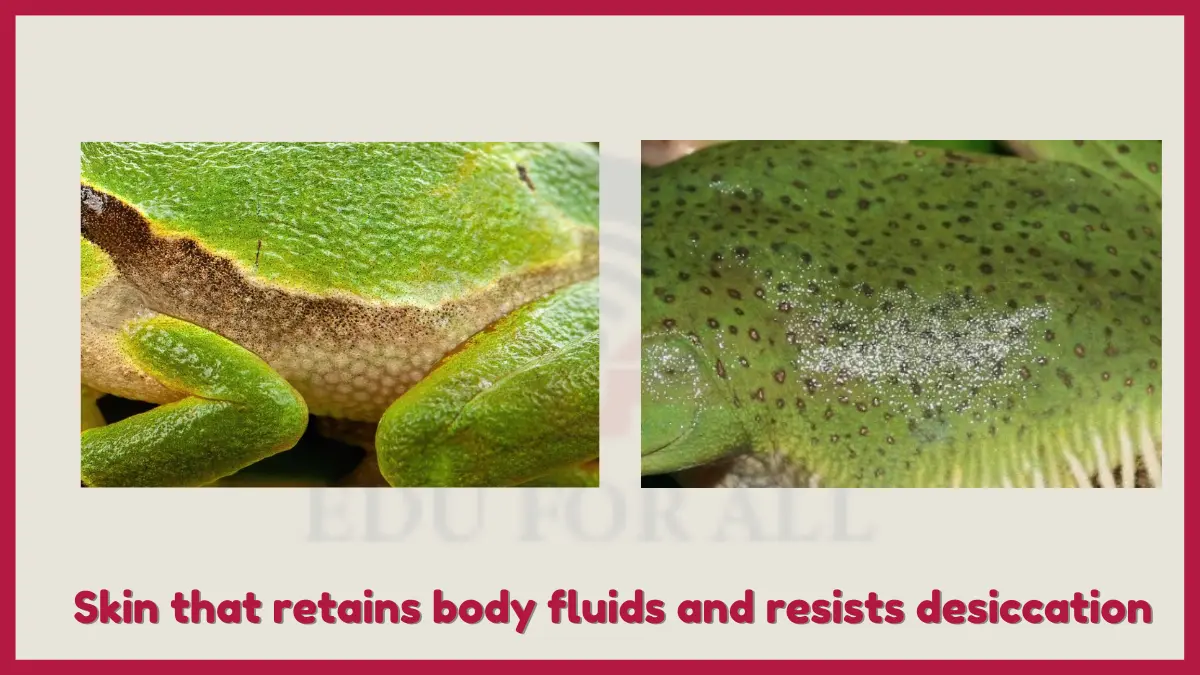
Classification of Amphibians
Amphibians are a diverse group of vertebrate animals that includes frogs, toads, salamanders, newts, and caecilians. They are classified into three main orders:
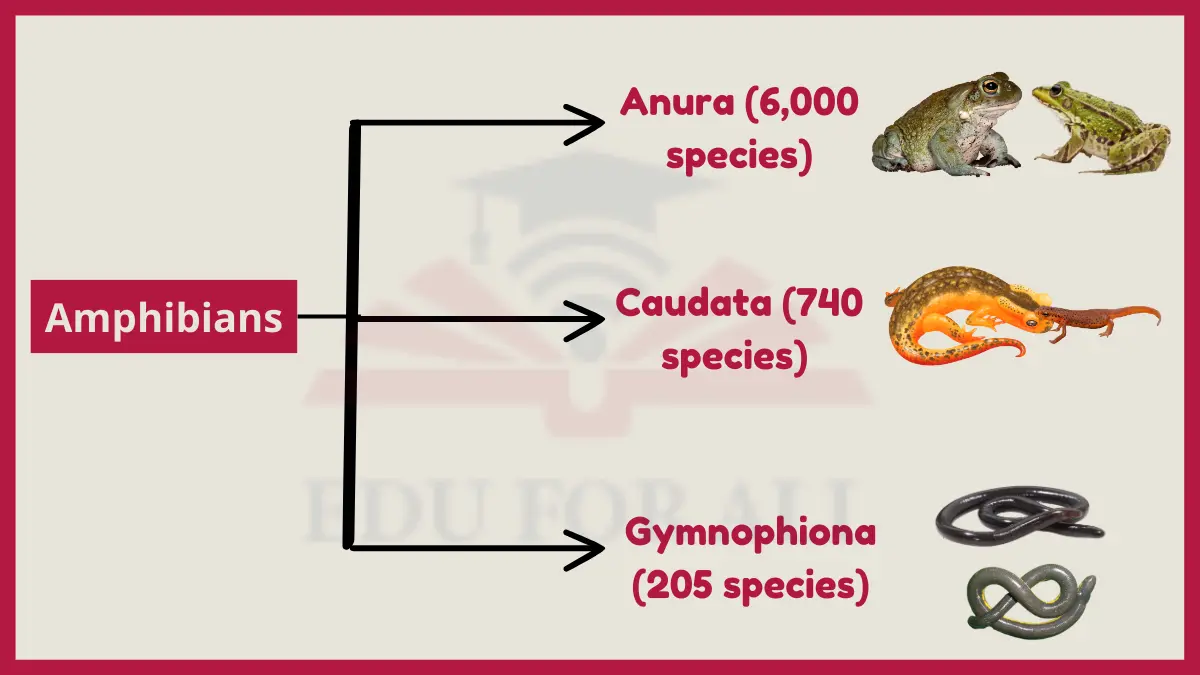
1. Anura (frogs and toads)
This order contains over 6,000 species of amphibians. Frogs and toads are characterized by their long hind limbs, which they use for jumping and swimming. They also have smooth, moist skin. Examples of Anura include bullfrogs, poison dart frogs, and toads.
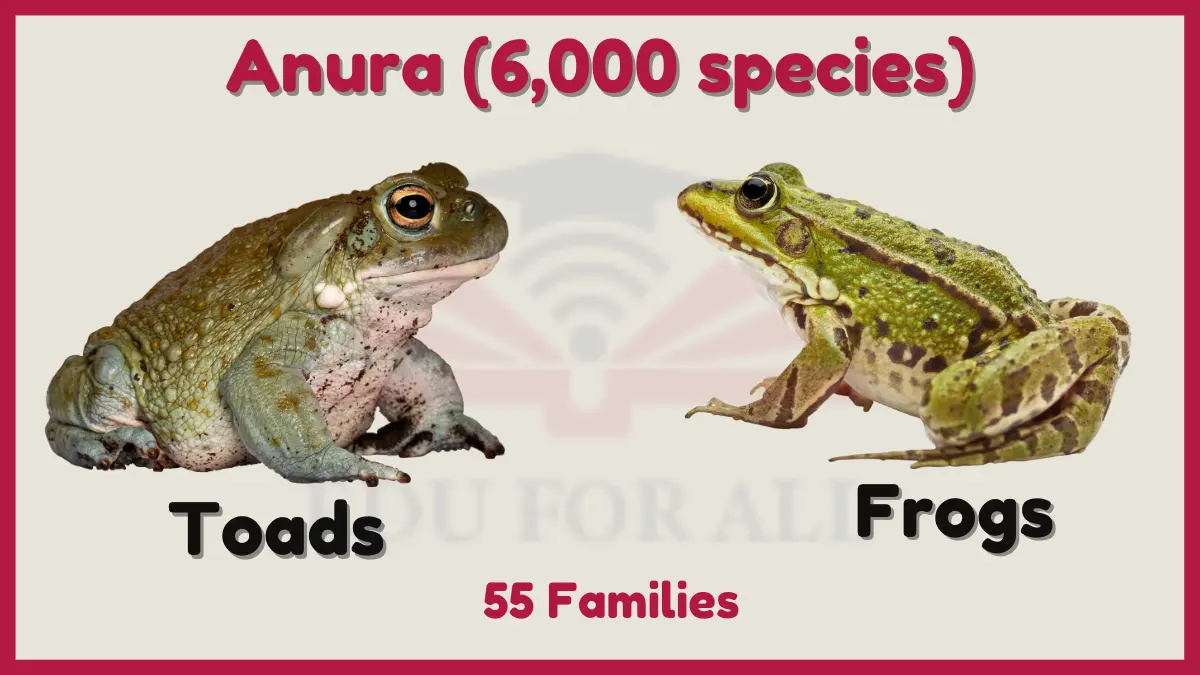
2. Caudata (salamanders and newts)
This order contains around 740 species of amphibians. Salamanders and newts have long tails and short limbs. Their skin is usually moist and glandular. Examples of Caudata include the tiger salamander, axolotl, and newts.

3. Gymnophiona (caecilians)
This order contains around 205 species of amphibians. Caecilians have elongated, limbless, snake-like bodies. They are adapted for underground burrowing. An example of a Gymnophiona is the common caecilian.
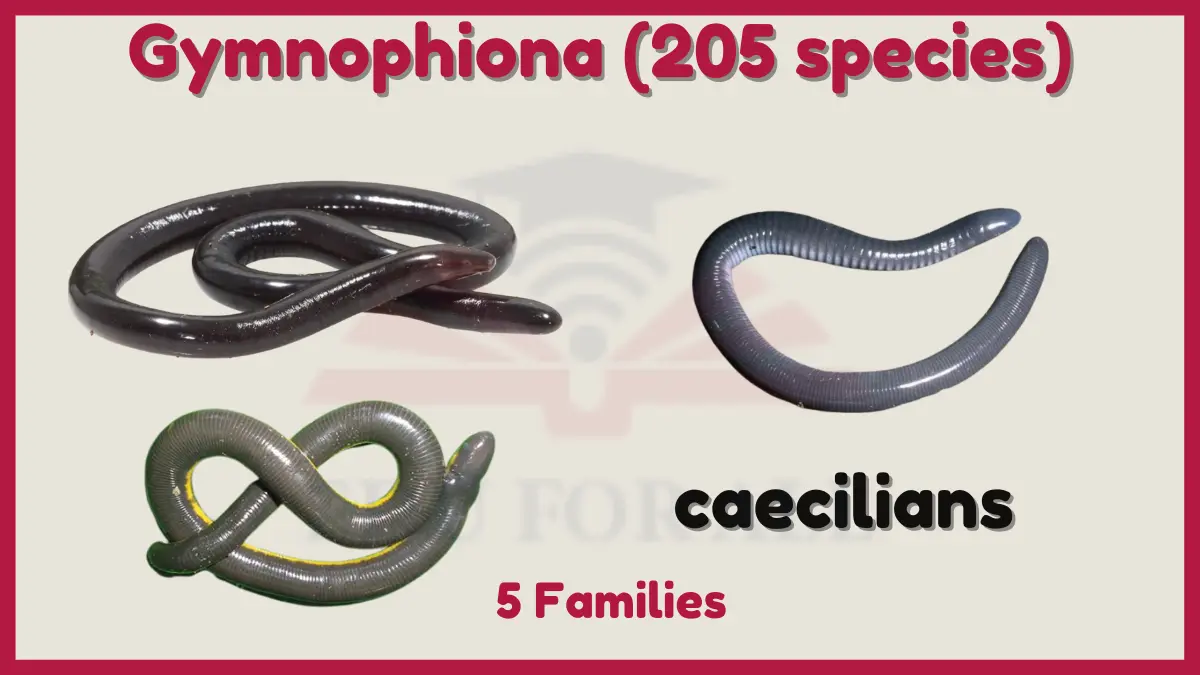
These orders can be further divided into families, genera, and species based on evolutionary relationships and anatomical similarities and differences. Some key distinguishing features used for classification include:
- Presence/absence of tail
- Skin texture and moisture
- Body shape and presence/absence of limbs
- Larval characteristics
- Reproductive strategies
Modern classification uses phylogenetic analysis of morphological, genetic, and behavioral traits to organize amphibians into evolutionary clades. Phylogenetic analysis is a method of studying evolutionary relationships between organisms by comparing their shared characteristics. It is a powerful tool for understanding the diversity and evolution of amphibians.
Number of families in each order:
- Anura: 55
- Caudata: 10
- Gymnophiona: 5
Characteristics of Amphibians
Amphibians have several unique physical features that distinguish them from other vertebrate groups like reptiles, birds, and mammals.
1. Amphibian Morphology
The bodies of amphibians are adapted for both aquatic and terrestrial habits. Their heads are wide and flattened with eyes on top and nostrils on the snout. Most species lack claws, scales, and external ear structures. Their bones are lightweight with reduced ossification. The limbs are short with 4-5 digits on each foot.
The moist, glandular skin lacks scales and is permeable to water and gases. It contains mucus glands that keep the skin moist. Many species have sensory papillae, or bumps, that give the skin a rough texture. The skin color can rapidly change using specialized pigment cells called chromatophores.
2. Amphibian Physiology
The physiology of amphibians allows them to transition between water and land during their lifecycle. As larvae, they have gills to breathe underwater through respiration. As adults, they develop lungs to breathe air. Some exchange gas through their moist skin as well.
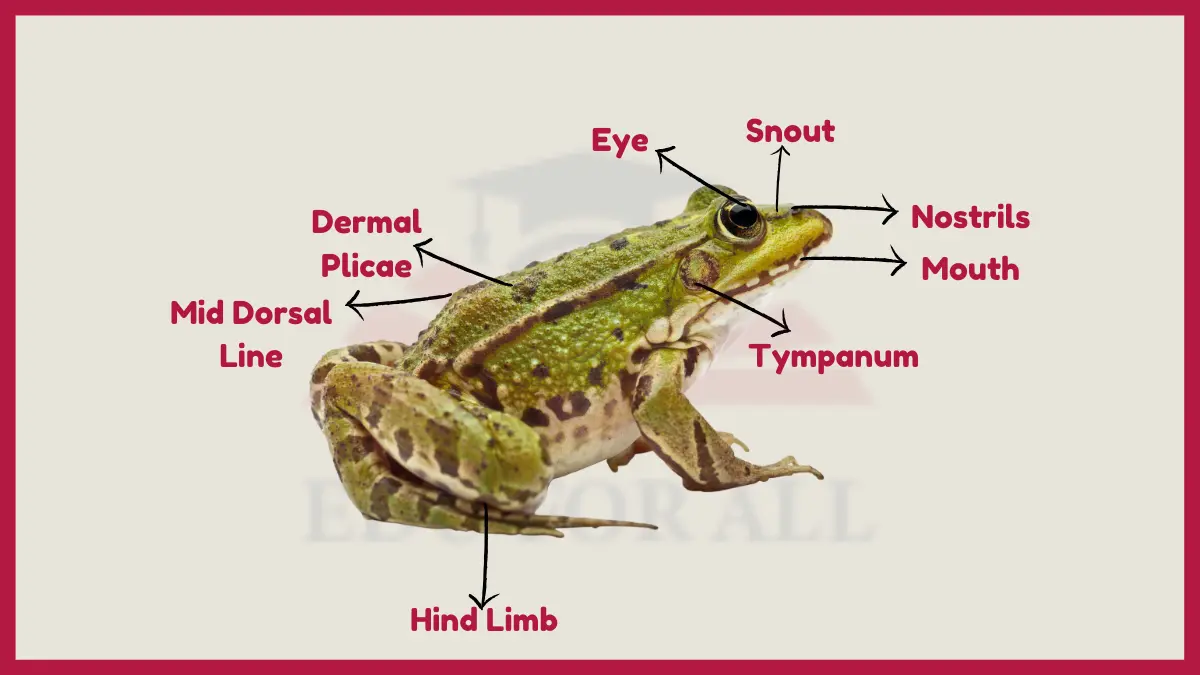
The heart has three chambers – two atria and one ventricle. Some oxygenated and deoxygenated blood mixes in the heart, reducing metabolic efficiency. They have a slow metabolic rate and low body temperature compared to other vertebrates.
3. Vocalization in Amphibians
Amphibians use their voices to communicate with each other, especially during the breeding season. Male frogs use their voices to attract mates and defend their territories. Female frogs also use their voices to communicate with males.
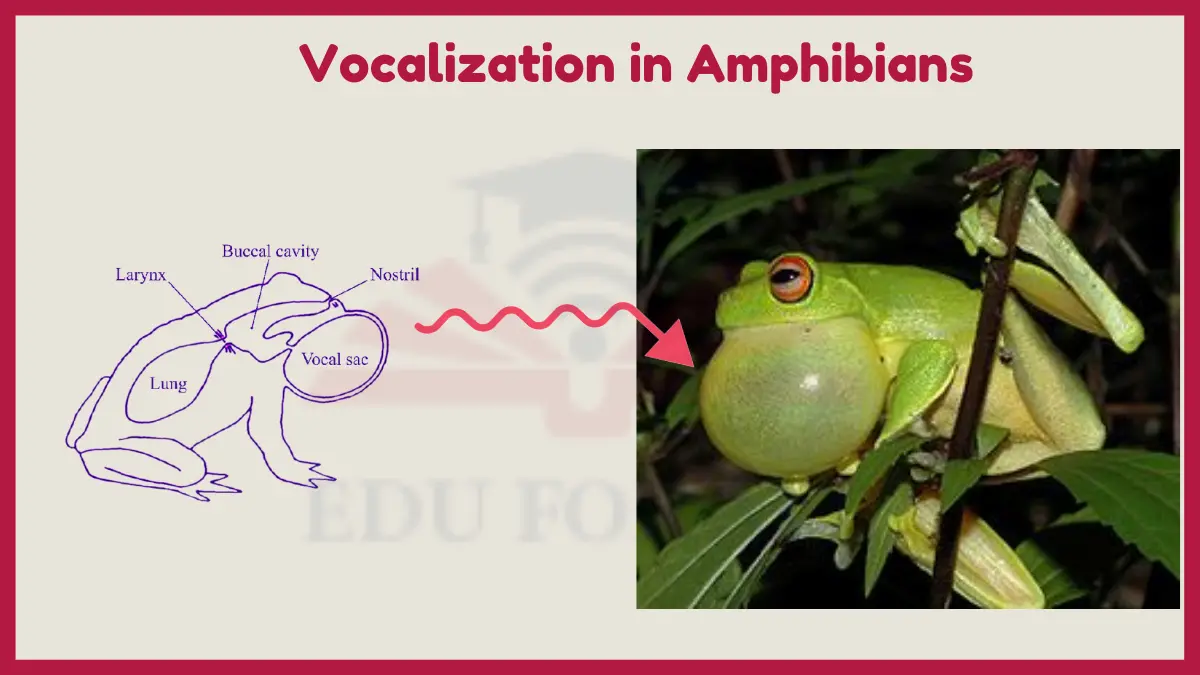
Amphibians produce sound by expelling air from their lungs over vocal cords. The sound is then amplified by air sacs located in the throat or at the corner of the mouth.
Females also vocalize, but their calls are typically quieter and less elaborate than those of males. Frogs may also vocalize to warn of danger or to express distress.
Here are some examples of frog vocalizations:
- Advertisement call: Used by male frogs to attract mates.
- Courtship call: Used by male frogs to attract a female that has responded to their advertisement call.
- Release call: Used by male or female frogs during unwanted attempts at amplexus.
- Distress call: Used by frogs to warn of danger or to express distress.
- Rain call: Used by some frogs to call during rainfall during daylight hours.
Amphibian Habitat and Ecology
Amphibians inhabit a diverse array of habitat types across the globe, from rainforests to deserts. However, most require moisture to prevent their skin from drying out. Amphibians play important roles in food chains and ecosystems as predators and prey. Their permeable skin and eggs make them valuable indicators of environmental health and pollution.
Amphibian Habitats
Most amphibians need access to fresh water for reproduction. Larvae develop in aquatic habitats such as ponds, lakes, swamps, and streams. Adults live in moist terrestrial habitats like forests, grasslands, and desert oases. Many species migrate between habitat types seasonally or during their life cycle.
Amphibian Food Chains
Larval amphibians are primarily herbivores, feeding on algae and plants. Salamander larvae are carnivorous, eating small invertebrates. Adults are mostly carnivores, eating insects, worms, snails, and smaller vertebrates like fish and frogs. A few groups have specialized diets – poison dart frogs eat ants while midwife toads eat spiders.
Here are some examples of amphibian food chains:
1. Pond food chain
Algae → Tadpoles → Dragonfly larvae → Frog → Snake
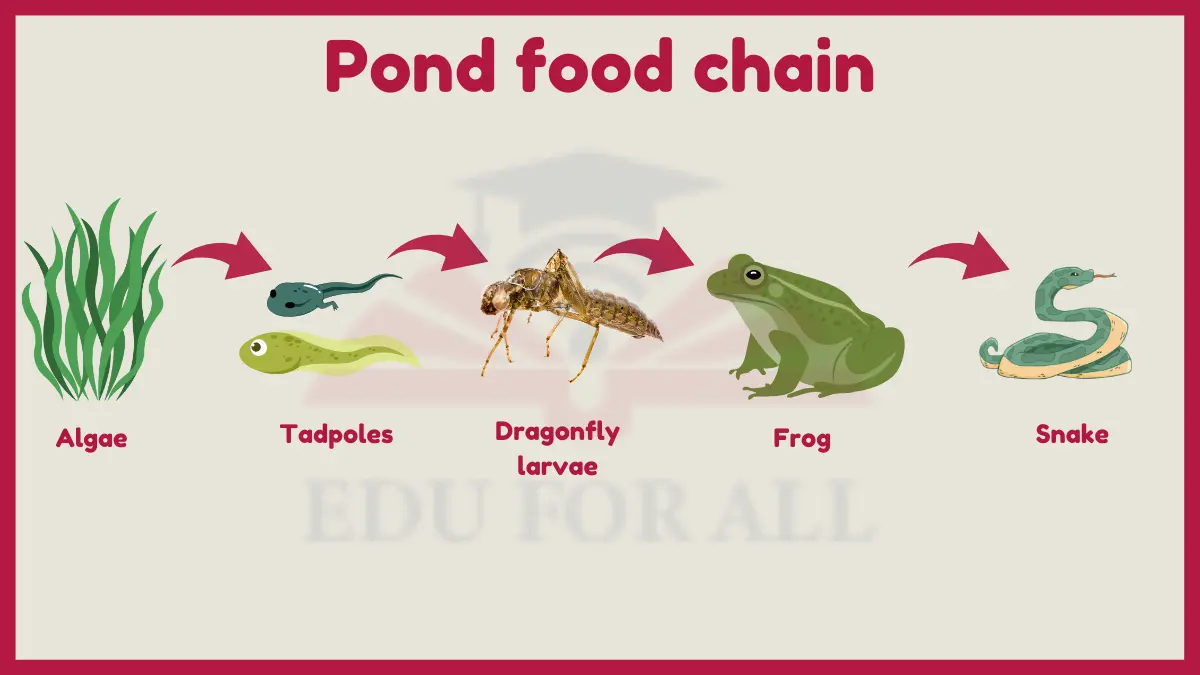
In this pond food chain, tadpoles eat algae as herbivores. Dragonfly larvae eat tadpoles as predators. Frogs eat dragonfly larvae and adults. Finally, snakes prey on frogs.
2. Rainforest food chain
Leaves → Crickets → Poison dart frog → Snake → Hawk
In the rainforest, poison dart frogs eat insects like crickets as carnivores. Snakes prey on the frogs, while hawks eat the snakes.
3. Desert food chain
Algae → Tadpole shrimp → Spadefoot toad → Garter snake → Red-tailed hawk
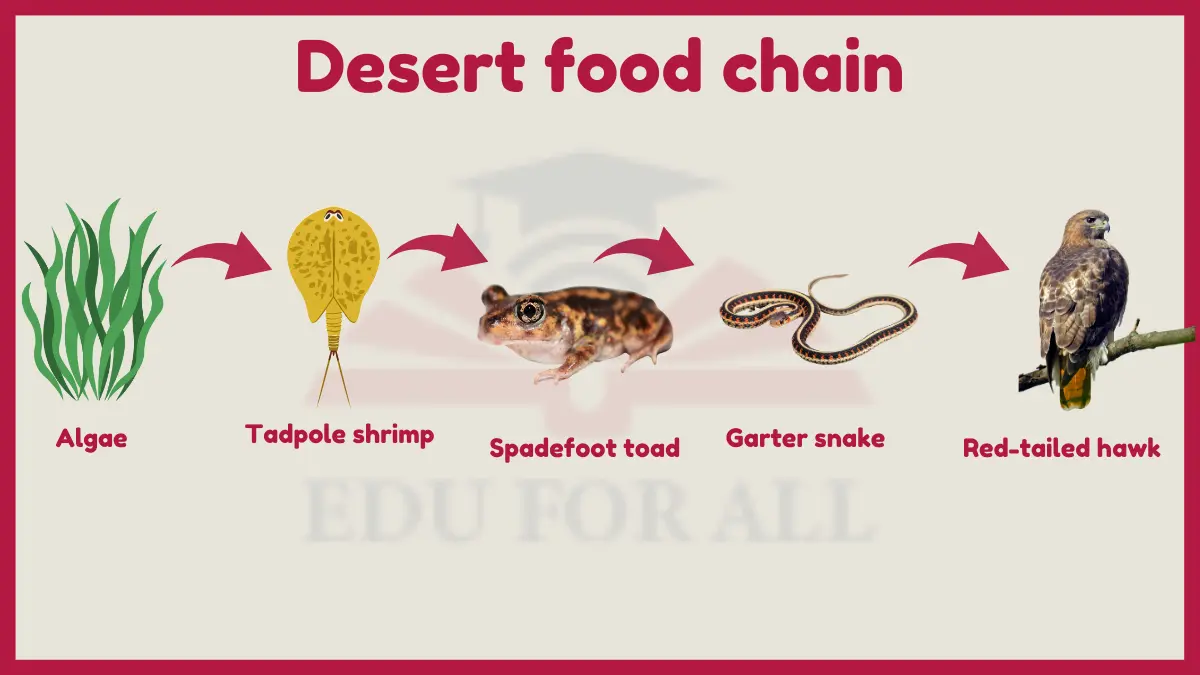
Spadefoot toads in the desert breed in temporary rain pools. The tadpoles eat algae and shrimp before metamorphosing. Garter snakes and hawks are higher-level predators.
4. Cave food chain
Fungi → Isopods → Salamander → Snake → Owl
In caves, salamanders prey on invertebrates like isopods that feed on fungi and detritus. Snakes enter caves to eat salamanders while owls grab snakes.
5. Vernal pool food chain
Algae → Fairy shrimp → Newt larvae → Garter snake → Coyote
Seasonal vernal pools have simple food chains. Newts breed here, and their larvae eat tiny crustaceans like fairy shrimp. Garter snakes and coyotes stop by to prey on newts.
Amphibian Predators
Amphibians play essential roles as both predator and prey in food chains. Their larvae are preyed on by fish, aquatic insects, birds, and other amphibians. Adults are eaten by snakes, mammals, birds, lizards, and even spiders. Their small size, permeable skin, and dual aquatic-terrestrial lifestyle make them vulnerable to many different predators.
Life Cycle of Amphibians
One of the most unique aspects of amphibians is their complex lifecycle that includes an aquatic larval stage and a terrestrial adult stage. This requires dramatic metamorphic changes in their morphology, physiology, and behavior.
Reproduction
Amphibians exhibit a diversity of reproductive strategies. Most undergo external fertilization of eggs in water. The male grasps the female and the female releases her eggs as the male releases sperm. However, some species like caecilians are viviparous with internal development. Parental care is simple or absent.
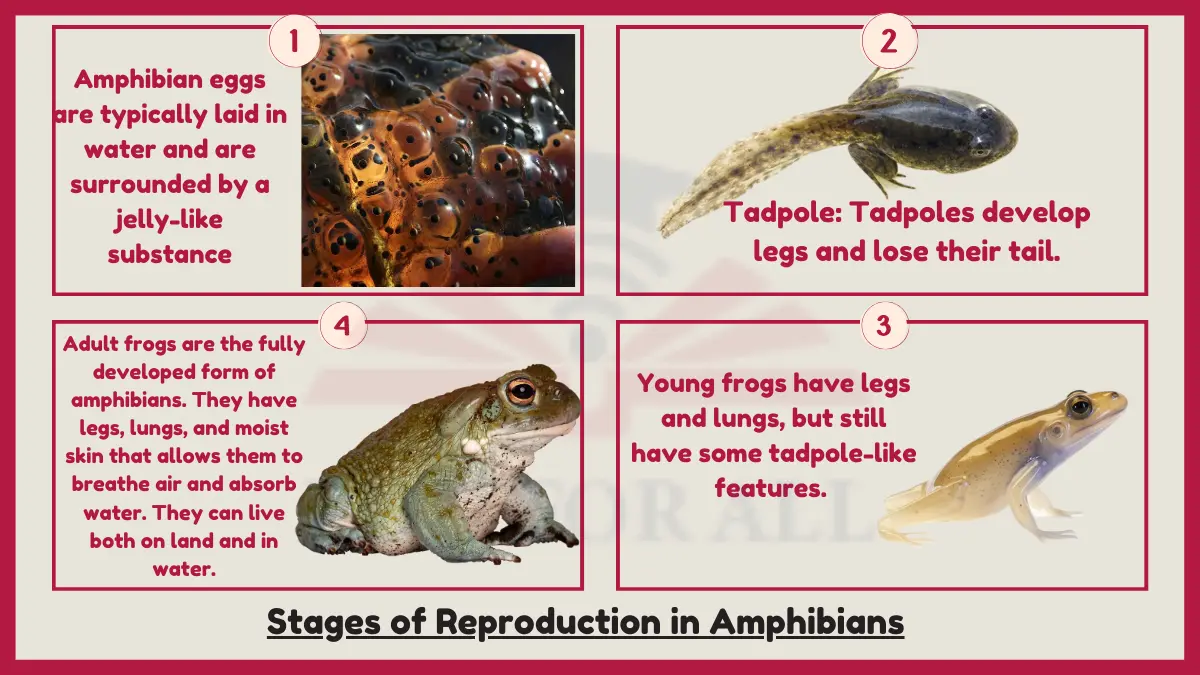
Amphibians need water to reproduce. Most amphibians reproduce sexually, but some species can reproduce through direct development. In most amphibians, the male fertilizes the female’s eggs externally. The male grasps the female tightly and releases sperm onto the eggs as the female lays them. Some salamanders fertilize the female’s eggs internally.
The male deposits a spermatophore, a small packet of sperm, on the ground. The female picks up the spermatophore with her cloaca and the sperm travel to her spermatheca, where they remain until ovulation.
There are two types of amphibian breeders: prolonged and explosive. Prolonged breeders congregate at a breeding site and lay their eggs over a period of time. Explosive breeders congregate at breeding sites after heavy rains and spawn rapidly.
Development
The eggs lack shelled membranes, allowing gas and water exchange. The eggs hatch into free-living aquatic larvae such as tadpoles or pollywogs. Larvae have gills, tail fins, reduced limbs, and lack eyelids. Larval development rates depend on temperature and species.
Amphibian eggs are typically laid in water and hatch into larvae. Larvae are young amphibians that live in water and have gills and fins. They eventually transform into adults, either aquatic or terrestrial.
Some amphibians, such as frogs and lungless salamanders, can develop directly, meaning that the larvae grow within the egg and hatch as miniature adults. Other amphibians, such as caecilians and some frogs, lay their eggs on land. The larvae either wriggle or are transported to water bodies.
A few amphibians, such as the alpine salamander and some African live-bearing toads, are viviparous, meaning that the larvae develop inside the mother’s body and are born alive. Other amphibians, such as some frogs, are ovoviviparous, meaning that the eggs develop inside the mother’s body but the larvae do not receive nourishment from her.
Metamorphosis
Frogs, toads, and salamanders all start out as tadpoles in the water. Tadpoles have gills and fins. Over time, they go through metamorphosis, which means they change their bodies to live on land. They lose their gills and fins, grow legs, and develop lungs.
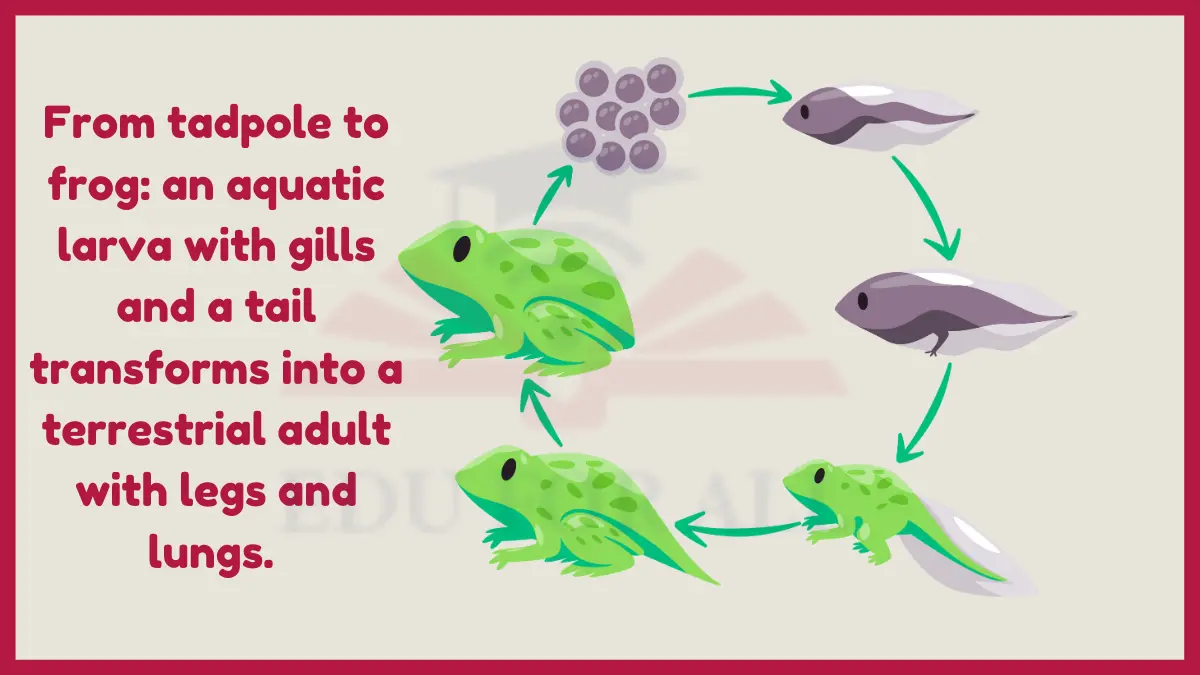
Metamorphosis is controlled by hormones. When the tadpoles are ready to change, their bodies produce hormones that make them grow legs and lose their gills. Metamorphosis is an important process for amphibians because it allows them to live on land.
During metamorphosis, the larvae transform into the terrestrial adult form. This involves dramatic changes: lungs develop, tail fins disappear, limbs develop, and the diet shifts from herbivore to carnivore in most species. Thyroid hormones drive these changes which may take weeks to years depending on the species.
The specific changes that occur during metamorphosis vary depending on the species, but some common changes include:
- Loss of gills
- Growth of limbs
- Development of lungs
- Change in skin texture and color
- Change in diet and behavior
Metamorphosis allows amphibians to transition from an aquatic lifestyle to a terrestrial lifestyle. This is important because it allows them to exploit new resources and habitats.
Defense Mechanisms of Amphibians
Amphibians have evolved a variety of defense mechanisms to protect themselves from predators. These include:
1. Mucous secretion
Amphibians produce a mucous secretion that helps to keep their skin moist and slippery. This makes them difficult for predators to grip and can also be distasteful or toxic.
2. Poison
Some salamanders, frogs, and toads have poisonous skin or glands. This poison can be fatal to predators, or at least cause them to avoid eating the amphibian in the future.
For example, the golden poison frog is one of the most poisonous animals in the world. Its venom can kill an adult human in minutes.
3. Warning coloration
Some poisonous amphibians have bright colors that warn predators of their danger. This is known as warning coloration. For example, the fire salamander has bright yellow and black spots on its back.

This coloration tells predators that the salamander is poisonous and should be avoided.
4. Camouflage
Many amphibians are camouflaged to blend in with their surroundings. This makes them difficult for predators to see.

For example, some tree frogs are green to blend in with leaves, and some toads are brown to blend in with dirt and rocks.
5. Defensive postures
Some amphibians have defensive postures that they use to scare away predators. For example, some toads will inflate themselves to make themselves look bigger and more threatening.
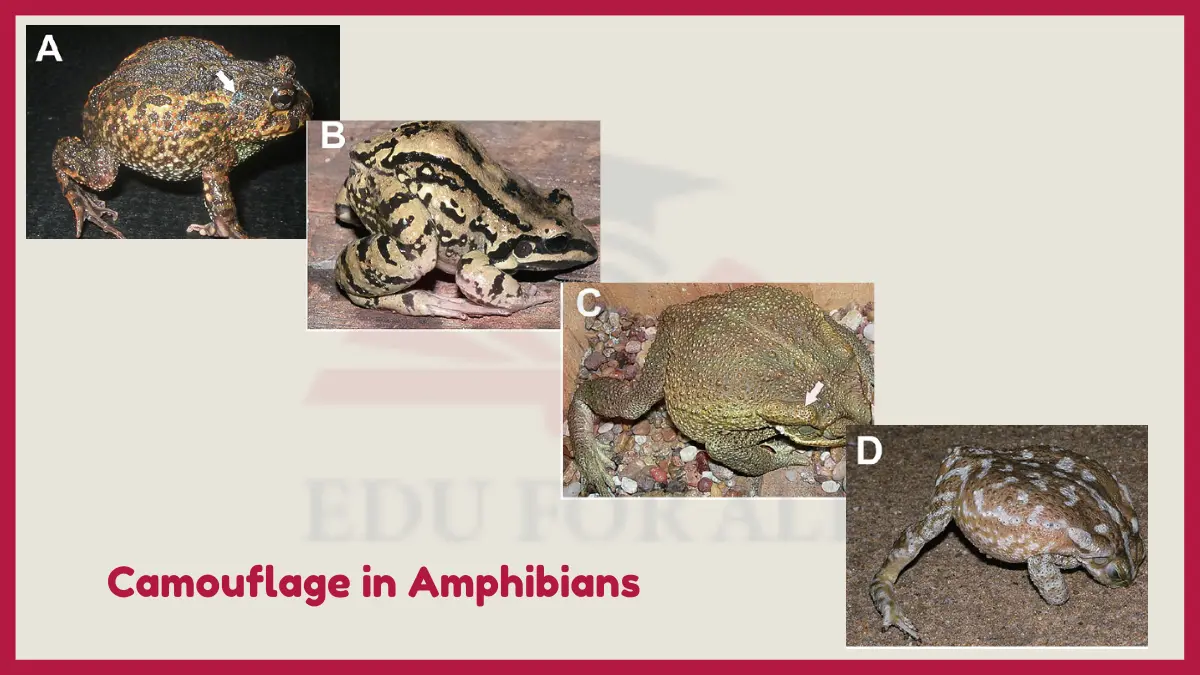
Other amphibians, such as the rough-skinned newt, will arch their backs and raise their tails to expose their poison glands.
6. Escape mechanisms
Some amphibians have escape mechanisms that they use to get away from predators. For example, some salamanders can autotomize their tails, meaning they can detach them if they are grabbed.
Other amphibians, such as frogs, can jump long distances to escape predators.
Threats to Amphibians
Amphibian populations have declined dramatically in recent decades. A third of amphibian species worldwide are threatened with extinction. Their complex lifecycles, permeable skin, and specific habitat requirements make them vulnerable to environmental changes.
1. Habitat Loss and Fragmentation
The destruction and breakup of their terrestrial and aquatic habitats is a major threat. Deforestation, filling wetlands, stream diversion, and water pollution all degrade amphibian habitats. Habitat fragmentation isolates populations, preventing dispersal.
2. Pollution
Amphibian eggs and larvae are highly sensitive to pollution like agricultural runoff and acid rain. Pollutants in the water cause deformities and reduce survival. Many pesticides, fertilizers, and other chemicals have devastating effects.
3. Climate Change
Rising global temperatures, declining rainfall, and increased UV radiation due to ozone depletion threaten some amphibian populations. Warmer, drier conditions reduce habitat quality and availability. Some species have limited physiological tolerance to temperature changes.
4. Disease
Fungal diseases like chytridiomycosis have caused massive population declines and extinctions in recent decades. The chytrid fungus infects amphibian skin, disrupting cutaneous respiration. Warmer global temperatures facilitate spread of the fungus.
Conservation of Amphibians
Protecting amphibian biodiversity requires multi-pronged conservation efforts focused on habitats, disease control, pollution regulation, and public education. Citizens can get involved through local conservation initiatives.
Conservation Efforts
Many conservation programs monitor amphibian populations, manage habitats, control invasive species, and breed threatened species in captivity. Biodiversity hotspots with many endemic species require priority protection. Restricting pet trade helps control disease spread.
Amphibian Behavior
Most amphibians exhibit simple behaviors mainly controlled by innate reflexes and responses. They communicate through visual displays, pheromones, grunts, and calls. Many species emit loud warning calls or release toxic skin secretions when threatened. Parental care is limited or absent in most species.

